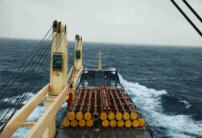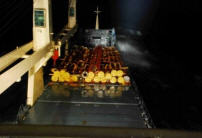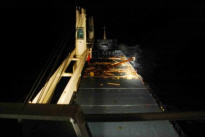What happened?
The vessel, which we cover for the owner's P&I risks, was on a time chartered voyage and an NYPE was entered into between the owners and charterers. Clause 8 of the head c/p was amended so that it was agreed that the stowage was to be "under the supervision and responsibility of the master".
The subject of this article involves a shipment of 20 very large diameter pipes, which were stowed on deck, with the consent of the shipper and in accordance with a booking agreement. This agreement was entered into between the time charterer of the vessel and the shipper of the cargo. In addition, one heavy piece of equipment was stowed on top of the second tier of large pipes. A bill of lading was issued on behalf of the master of the vessel to cover the carriage of the cargo to a United States port. During the voyage, the vessel encountered heavy weather, during which, 19 of the units of large pipes and the one heavy piece broke stow and were lost overboard.
What was the result?
A lawsuit was filed in the United States against the vessel and her managers for the full value of the 19 units which amounted to about USD 2.5 million. While a final resolution of this loss has not yet been achieved, we will need to engage counsel to defend our members and to assert the normal defenses. In addition, the owners of the vessel had to appear to protect the interests of the vessel and a defense has been filed to protect the managers. Finally, a third party complaint has been filed to bring into the action the time charterer of the vessel.
Why did it happen?
There are two aspects to this question. The first refers to the loss of the cargo overboard and the second concerns the inability of the member to limit its liability along the terms that were contemplated in the head charter party, the booking agreement and the bill of lading.
1. From our surveyor's report, we believe that the cargo was improperly stowed and inadequately lashed and secured, which was done by the shipper and later approved by their surveyor. The surveyor reported and the contracts reflect that the shipper had arranged to have special cradles built to accommodate the pipes on deck. However, photographs that we have obtained show the loading and stowage at the loading port and reflect several things:
- The cradles may not have been of a sufficient length
- The cradles were not secured to each other to create a block stow
- The dunnaging of the pipes, resting in each cradle, were not sufficiently blocked to avoid any movement
- The heavy piece on top of the pipes was not sufficiently lashed and secured
- The pipes and cradles were not adequately lashed and secured to the vessel rather than to each other.
As a result, when the vessel was affected by the heavy weather during her voyage, the pipes were allowed to move within the cradles and the cradles were allowed to shift. This quickly evolved into the failure of the lashings and the cargo falling overboard.
2. Since neither COGSA nor any Hague scheme applies to on deck carriage, where the fact of an on deck carriage is noted on the face of the bill of lading, COGSA must be contractually incorporated. Consequently, with respect to the question of the carrier's inability to limit the exposure for the loss of 19 pipes to the usual application of the US COGSA package limitation, legal expenses will be incurred to assert the usual defenses as a result of the failure of the charterer to contractually incorporate the application of the terms of COGSA and the Package Limitation into the booking note. The booking note was entered into between the shipper of the cargo and the charterers, and failed to similarly contractually incorporate the same terms of COGSA and the application of the Package Limitation defense into the bill of lading that was issued to cover the cargo.
What can we learn?
- Since the head charter party placed the loading and stowage of the cargo under the supervision and responsibility of the master, and the shipment in question was intended for on deck stowage, it should have been assumed that the cargo would be oversize and, probably, high-priced. The owners should have protected themselves by having a surveyor in attendance during the loading and stowage of the cargo. It could then be argued that the stowage, which was performed by the charterer and/or the shipper, would have been different and the loss would have been avoided.
- In addition, even when the shippers are in agreement that the stowage of the cargo would be on deck,(this must be noted on the face of the bill of lading), it is imperative that the terms and conditions of US COGSA be contractually incorporated onto the controlling bill of lading and/or charter party. Even in the face of having to assume the liability for the loss, the exposure would be easily limited to the package limitation without providing any claimant an opportunity to challenge the usual defenses. Further, the bill of lading should have been issued by the charterer. These details could have made the difference between settling this claim for USD 9,500.00 and avoiding extensive litigation and the incurring of legal fees to assert the usual defenses.
- It was not an accident that the managers were named in the lawsuit as the claimants are aware of the fact that COGSA recognizes an owner or charterer as carriers and does not provide the same protection to a manager. Under COGSA, the manager does not enjoy the benefit of any package limitation nor time limits. Consequently, since the bill of lading was issued by or on behalf of the master, both the charter party and the bill of lading should have contained an Himalaya Clause, naming the managers, which would have provided the protection that the managers need as an agent of the owners.
|
|
|
|


